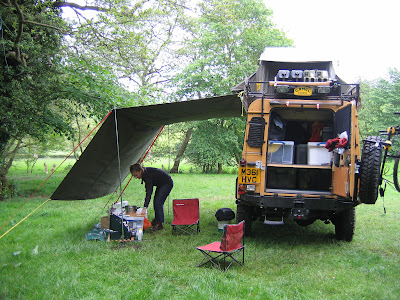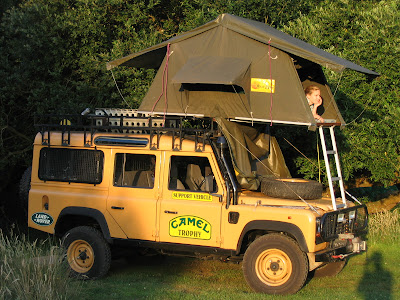In the mountains of France we noticed the Land Rover began running very hot. This had never been a problem in the UK, but the vehicle was now heavily loaded, the hills were much bigger and steeper, and the air temperature much warmer. We replaced the thermostat as a precaution, but a check of the one removed indicated that it was working fine. Since then, we have taken the climbs slowly in a lower gear to keep the revs up and keep the fan spinning, and this seems to keep the needle out of the red.
After having the A/C regassed before we left, we have noticed evidence of the gas leaking around the receiver/dryer, with compressor oil being deposited on the receiver/dryer. As time has passed the A/C is not as cold is it once was. We have delayed having this looked at until Jordan, and hopefully our man Charlie Kayal will come through with the goods.
Also in France we noticed abnormal toe wear on the tread of the front tyres. This indicated the wheel alignment needed correcting, which we managed to have done by ESKA in Munich. We originally tried Euromaster, but they were too scared to put they vehicle on their hoist because they thought it would overload it! ESKA also balanced five of our six wheels. Just prior to doing the alignment they picked up that one of the tie rod ends needed replacing and pointed us to the local dealer where we could get the part. We ended up having both tie rod ends and the drag link end all replaced at once, keeping the old parts for spares. Pitstop in Munich, next door to ESKA, carried out this work.
We had a few fuel supply problems one day when we let the main tank get too low before switching to the side tank. The fuel system is self bleeding, so this eventually cleared. In the meantime, I gave the sedimenters both a bit of a flush through. These are like large initial fuel filters that get the worst of the water and contaminants out.
The air cleaner housing managed at some stage to shake free of two of its four rubber mountings. This has been secured with a bit of fencing wire for the meantime. New Zealanders know always to carry fencing wire…
Ever since we had owned the vehicle, there had occasionally been a bit of a ringing clunk when pulling away. It had sounded like a universal joint, but I was unable to detect any movement in the joint. This did eventually get worse and to a point where movement in the joint could be seen. We changed the joint in Bulgaria, and just in time because there were no bearings at all left in one of the cups. Normally I would change the joints at each end of the shaft at the same time, but because of the conditions (we were in a forest, not a workshop), I elected to just do the one.
After slightly more than 6000 miles we finally found a suitable location to carry out an oil change. We managed to pick up a few more filters at dealers along the way, so hopefully will have enough to keep us going. Once out of Turkey the quality of the diesel drops, with very high sulphur content, so consequently intervals between oil changes will need to reduce, even down to 3000 miles.
We have had one puncture so far, in Turkey. This was only a very slow leak, so initially carried on, reinflating the tyre each morning. There were a lot of “Otolastik” sheds around in Turkey, but we could afford to wait until we found a decent shop with balancing equipment. Lassa was just what we were looking for. Excellent service, and spotless workshop (that always impresses me), air conditioned waiting room, and it was cheap.
While the Camel was standing on the spotless Lassa floor. Catkin noticed a few spots of oil below the front diff (easier to see from her slightly lower vantage point no doubt). Closer inspection revealed very fine cracks in the welded seam on the front of the diff. The diff hadn’t had a knock of any sort, so we can only put it down to some stress in the weld manifesting itself. It was only losing a few drips a day, and the oil level was not noticeably lowering, but nevertheless it needed to be seen to. We managed to get it welded by Badia 4x4 in Jordan, and the problem is fixed. Because their service was so good and their rates reasonable, we also got them to inspect the front right wheel bearings, which were slightly loose allowing a small amount of movement in the front wheel, and while they had everything apart to check the CV joint. This had been making a bit of the clicking noise, so needed looking at. It turned out that the Swivel Housing, where the CV joint does its job, had no lubrication. In fact, some water came out! The Swivel Housing had at some stage been filled with Land Rover swivel housing grease, but over time this had all disappeared. The original bearings and CV all appeared suitable for reuse, so everything was reassembled with new gaskets and lubrication.
.JPG)
The left rear indicator stopped working in Damascus, so no one behind us could see the light. What I had hoped to be a simple blown bulb turned out to be a broken terminal in the bulb holder. Luckily, if you have enough different types of wire you can fix anything (not fencing wire this time though).
In Umm Qais, I noticed the clutch pedal suddenly felt very spongey. This was simple – top up the reservoir with fluid! Should have checked that sooner.
I know it’s a Land Rover and we should expect a few things to need fixing, but we haven’t even got to the really rough stuff yet!
Notes on the Carnet
We purchased our Carnet from ADAC in Munich. We originally enquired with the RAC in the UK, but the costs were much greater than from the ADAC. Catkin got to put her German skills to good use making all the arrangements by email. We went in to the ADAC office with 5150 euros in cash, 5000 of which we get back when we return the properly completed Carnet at the end of the journey. Total cost to us 150 euros. With the RAC, both the cost and the deposit were much higher.
.JPG)


.JPG)

.JPG)
.JPG)
 A farm campsite near the Jurassic Coast
A farm campsite near the Jurassic Coast  We had a great time in North Wales...
We had a great time in North Wales... ...and a nice night in a deserted New Forest campsite out of season
...and a nice night in a deserted New Forest campsite out of season 